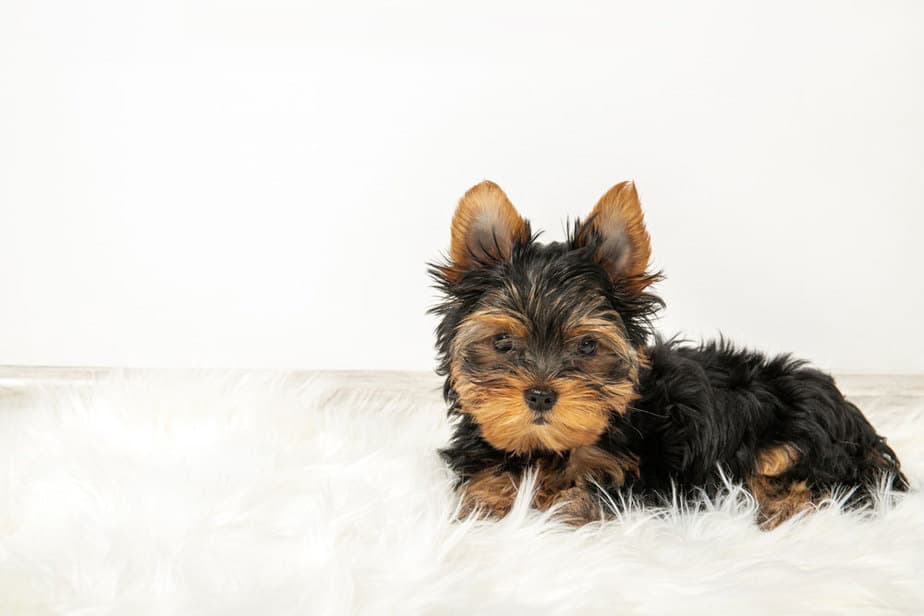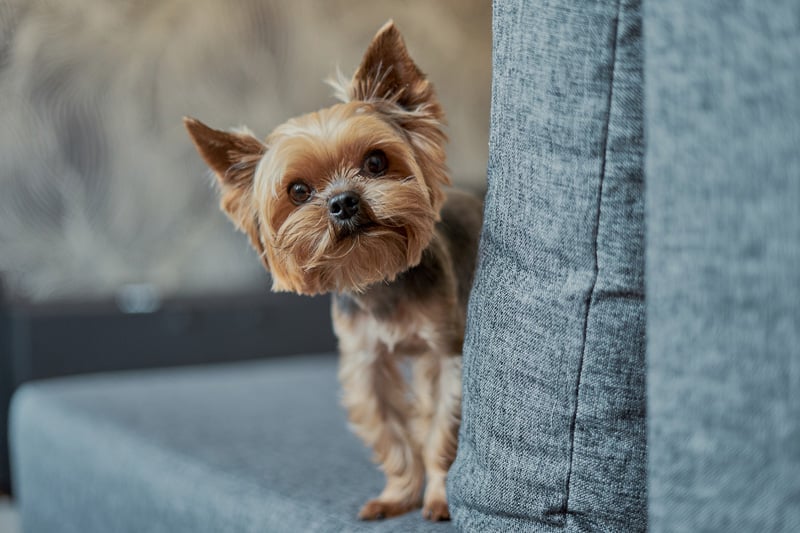If you have found that your Yorkie puppy is having trouble with house training, is over excitable, is fearful of car rides, or is sleeping under the bed, then you should absolutely crate train your puppy.
You might have already decided that you want to crate train your Yorkie, and if you’ve come to this decision it’s definitely the correct one. But if you’re still on the fence, let me assure you now that you won’t regret it.
Crate training is not cruel, but it’s how you implement it that matters. It’s important that you follow some guidelines to ensure a positive transition to the crate.
We’ve compiled a list for you to follow so your Yorkie puppy transitions quickly and effectively to their new crate.
If done correctly, your Yorkie will see their crate as their safe space where they go to relax and feel secure, and it will provide you with a much overall better-behaved puppy.
Crate Training a Yorkie Puppy
Yorkie’s benefit more from crate training than most breeds. This is because they flourish with routine, as it gives them a sense of structure in their lives. Structure gives them boundaries and shows them what is the appropriate behavior at any given time.
Yorkies are beautiful dogs with big personalities and big hearts, but they are known for their stubbornness and can be difficult to house-train. Also, if left to their own devices, they will soon become rulers of the household.
Having a crate for your Yorkie puppy will help you maintain control over any unwanted behaviors. Don’t get me wrong though, a crate is not a place for punishment, but by just having a crate, your Yorkie will be a more relaxed, calm dog who is easier to manage in your home.
In turn they will be happier for it, and so will you!
Benefits of Crate Training a Yorkie
Housebreaking Using a Crate
Yorkie puppies are known to be notoriously difficult to housebreak. By having a crate for them, they will be reluctant to pee or poop in such a small area, and one they’re inhabiting. Which means they’ll do their best to hold onto it. This will exercise their will power and understanding of self-control.
When your Yorkie puppy has spent some time in their crate, take them straight outside and use a command such as, “Potty.” And when they go, reward them generously with treats and praises.
Note: Ensure you clean up any messes you find in the crate as soon as possible. You want their crate to be a clean environment that they want to be in.
Unsupervised Time
Sometimes we can’t always supervise our puppies. Yorkie puppies can get into all sorts of mischief when we’re not watching.
If you’re cooking in the kitchen and find your pup is under your feet creating a hazard, then a short time in their crate is acceptable.
Want to have a bath, or perhaps someone is at the door? These can be good times to use a crate to give them a safe, unsupervised space while you have to attend to other things.
Although puppy proofing your house is a must with any puppy, let alone a Yorkie, you never know what mischief they can get up to when you’re not watching. Sadly, many puppies succumb to ingesting things they shouldn’t around the home and having a crate can greatly reduce this risk.
Safe and Sound
This is the number 1 reason to crate train a Yorkie puppy. The crate is their home within a home, a place to feel safe. How do you feel about your bed? It’s your refuge and your most personal space. This is the same for your Yorkshire Terrier puppy.
This is especially important in a house with children and/or other pets. It gives them a sanctuary that is all theirs.

Boarding Kennels
If you ever find yourself needing to leave your Yorkie at a boarding kennel, there’ll be less chance of them having a traumatic experience if they’re already used to a crate at home.
And if they’re accustomed to spending time alone in their crate, they will have a stronger sense of independence when you can’t be there.
Time Out
We don’t recommend you use your crate for this; however, some trainers recommend that you can use your crate for a puppy time out.
If your Yorkie has taken to nipping the ankles of a visitor, then you should give them a time out and you can learn more about that in our blog: Does Your Yorkshire Terrier Keep Biting?
But we suggest you have a fenced off area for this purpose, or in a room of the house such as the laundry, although ideally you want them to still be able to see you as you ignore them.
The reason we suggest staying away from using a crate as time out is you must be careful not to associate ill feelings towards their crate.
If you feel you still want to try it, then we recommend you placing your pup into their crate with a gentle hand and a quiet voice. Never scold them when placing them into their crate as this will ensure they reject it.
Travelling with a Yorkie Puppy
If you ever need to take your Yorkie in the car for a long distance, or on a flight, then they’ll already be accustomed to a confined space, and will have less difficulty in staying calm and enjoying the ride.
Vet Visits
God forbid your Yorkie pup ever needs to have an operation, but if they do, then at least you will know that your pup won’t be too put out by being placed into a confined space before and after treatment.
Crate training can also prevent issues with irritating stitches and wounds post operation, as they will be less inclined to move around their enclosed space as they wrestle with their new found confinement.
Holidays and Thunderstorms
Loud noises like fireworks and thunderstorms can be traumatic for many puppies around the world. If your Yorkie puppy has a crate, then they can retreat into it during these times.
And if need be, you can even cover their crate with a blanket to soften the noise, giving them a cave to hide in and alleviate some of their fear.
Routine for Behavior
As already touched upon, Yorkie puppies benefit greatly from having a set routine. A crate will go a long way in letting them know when it’s time for play and when it’s time to rest. Don’t underestimate how beneficial this can be for your Yorkshire Terrier.
If you have a Yorkie puppy who is misbehaving, you might find this article helpful: When Will My Yorkie Puppy Calm Down?
Setting up Your Yorkie’s Crate
Firstly, before you start your crate training, it’s paramount that you have set it up correctly. This means the right size crate for your Yorkie, as well as having everything you need to keep them comfortable
To choose the right size you want to ensure your Yorkie puppy can comfortably stretch out, stand up, and turn around within its interior.
A 22-inch size crate will be suitable for your Yorkshire Terrier puppy. We also recommend that you also choose a double door option.
When first training them to warm to their crate, it’s a good idea to leave two doors open, to make it as inviting as possible. And by having a double door it will also give you greater flexibility for access.
Here is a great 22-inch double door from Chewy.com. We like Chewy because we can get direct 24/7 customer support and assistance, and they’ve always been great to work with.
TIP: Don’t go too big, the effect of a cozy den may be lost, but worse, they could use it as a toilet and defeat your plans of housebreaking them!
You might also want to read our post Puppy Pees in Crate: What to do…
You want to make the inside of your puppy’s crate as comfortable as possible. Our choice is the Frisco Micro Terry Dog Crate Mat, which is a great soft mat to put into your pup’s crate to give them warmth and comfort.
The Puppy Play Mat is our best-selling product and many pups have had them in their crates to great success. They provide the softness of the play mat’s memory foam, can be machine washed, plus have toys for your pup to chew on.
A Puppy Play Mat with a Frisco Dog Crate Mat together make a great combo to have a complete puppy crate solution. Just throw in a small blanket too and you’re all set!
The Smart Pet Love puppy behavioral aid is the perfect product to keep your pup feeling safe and sound inside their crate, especially when feeling lonely or when there’s a thunderstorm.
A good chew toy like a Kong is also a good idea to have in their crate for when they’re teething.

How Long to Crate Train a Yorkie Puppy?
A Yorkie puppy can be properly crate trained within 3 weeks. This will require persistent and diligent training.
However, because Yorkshire Terriers can have a stubborn nature and a strong desire to be with you at all times, it can take longer than other breeds to accustom them to their crate. Of course, each Yorkie has their own personality, and some will take to it like a duck to water!
The most important thing when going through the crate training process is that you stay consistent. The more inconsistent and wishy-washy you are the longer it will take.
How to Crate Train a Yorkie Puppy
Now let’s get into the nuts and bolts of how to crate train your Yorkie puppy. Here is the best method for teaching a Yorkie puppy to love their crate!
Always keep in mind that you want to make the crate a positive place to be. This can be done by putting their favorite things inside their crate, as well as plenty of treats! Have this attitude and you can’t fail.
Introduce Yorkie Puppy to Crate
- Put your new crate in an area of the house where everyone spends a lot of time.
- Keep the door of the crate in the open position at all times during this stage.
- Show your puppy the crate and use praise and your best friendly puppy voice. Let them sniff around and become familiar with it.
- Put some treats inside the crate so they enter and exit freely.
- Put a couple of their favorite toys inside the crate.
- To succeed in this stage of introduction, you want your puppy to go in and out of their crate freely and happily.
- Another reason to have a metal cage design crate is that you can feed treats through the closed door. But in this introduction stage, be sure to open the door again quickly to show them that it’s safe.
TIP: During this stage never force them to go inside their crate.
Crate Mealtimes
- From the first day of crate training, begin feeding them their meals inside their crate.
- If you can, move their bowl to the back corner of the crate.
- When they’re eating, gently close the door and leave it closed until they’re finished. Then open the door and praise them.
- After each meal, begin leaving the door closed a little longer. Make sure you never leave their side during this time.
- After several meals you should have the door closed for at least few minutes after feeding.
- Keep this routine up until you reach the ten-minute mark, and be present in the room but not by their side.
TIP: The key is to go slowly. You don’t want to extend the time too quickly or they may begin to cry and whine.
If this happens you’ve moved too quickly, and you should immediately let them out. However, if they continue to whine on successive attempts, do not let them out until the whining has ceased. You definitely don’t want to teach them that whine equals keys to the door!
Independent Crate Time
It’s time to teach them independent stay time in their crate.
- Once they are up to a reasonable amount of time in their crate after meals, it’s time you try leaving the room.
- Briefly leave the room for a few minutes and come back. Go to their side and praise them and remember, treats inside the crate are reinforcing that positive environment.
- A few minutes after returning, open the crate door and have some play time.
- During the next meal, repeat the process. Let them eat with the door closed, spend some time in the room, and then leave, extending that time where they can’t see you.
- Be sure not to return when they whine. Make sure their whining stops before coming back and letting them out.
- Increase this pattern until you can be out of sight for 30 minutes.
TIP: If they nap at all during this time inside the crate after feeding congratulations, you’re doing great! Once they wake up, be sure to let them outside for toilet time.
Night-time Crate Training
It’s now time to test them out in the crate at night.
- Put the crate next to your bed, or at least close by.
- Work on obedience training before bedtime.
The key to a well-behaved Yorkie is having a good routine, and so training before bedtime can work well to strengthen this routine. It will not only tire their minds out for a sleep but will also ques them to subconsciously know that bedtime comes next.
- After each night, move the crate further and further away until you have them in your desirable position for sleep time.
How Long Can I Leave My Yorkie Puppy in a Crate?
This will entirely depend upon their age. The below chart will give you a good guide to follow, however is a guide only and every puppy can be slightly different in their bladder control and tolerance for crate time.
| Puppy Age (months) | Bladder Control (hours) | Total Daily Crate Time (hours) |
|---|---|---|
| 2 | 1 | 1 |
| 3 | 2 | 1 – 3 |
| 4 | 3 | 3 – 4 |
| 5 | 4 | 4 – 5 |
| 6 | 5 | 4 – 5 |
| 7 | 6 | 4 – 6 |
| 8+ | 6 Max. | 4 – 6 |
The above table excludes night sleeping hours. Any long duration of time spent in the crate throughout the day should be mostly avoided. If you have little choice but to give them a longer duration in the crate, they will still need adequate socialization, food, water, play and exercise.
Long term use of sustained periods of time in a crate can be detrimental to their mental health.
Yorkie Terrier Whining in the Crate
Whining can become a problem when crate training your Yorkie puppy. It’s important that you get on top of it before it become unbearable where you would have to start your crate training over.
Consider the following points to avoid this issue:
Be careful not to act on any whining. By doing so, you will only encourage the behavior.
Be sure to let them out for regular potty breaks. By doing this you will know they’re whining because they want to get out and play or do other things, not because they need to desperately wee. It can help to set an alarm at night to take out your puppy regularly. They have little bladders and need this in their first year.
Only let them out once the whining has stopped.
If you know that your puppy’s whining is because they are desperate to go to the toilet, then you have no choice but to take them out. Do not be playful, only say a command for using the toilet, such as, “Pees and Poos” and wait. Once they go, you can settle them again in their crate. Do not give into any further whining.
Final Word
There is nothing more rewarding than having a well-behaved dog, but it doesn’t come easy. As owners we have to work at it, but by having a good knowledge of how to implement good behaviors, we can make it easier on ourselves.
Crate training is one of our biggest tools to curb unwanted behaviors in puppies, and some breeds, such as Yorkshire Terriers, will benefit more from this type of tool.
Once implemented you will find your Yorkie puppy to be less of a boss and more of a comforting and loving companion.




